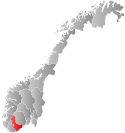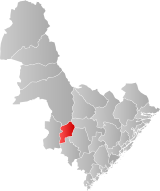Evje Municipality
Evje herred | |
|---|---|
 View of the local church | |
 Aust-Agder within Norway | |
 Evje within Aust-Agder | |
| Coordinates: 58°35′06″N 07°48′30″E / 58.58500°N 7.80833°E | |
| Country | Norway |
| County | Aust-Agder |
| District | Setesdal |
| Established | 1 Jan 1877 |
| • Preceded by | Evje og Vegusdal Municipality |
| Disestablished | 1 Jan 1960 |
| • Succeeded by | Evje og Hornnes Municipality |
| Administrative centre | Evje |
| Area (upon dissolution) | |
• Total | 177 km2 (68 sq mi) |
| Population (1960) | |
• Total | 1,646 |
| • Density | 9.3/km2 (24/sq mi) |
| Demonym | Evdøl[1] |
| Time zone | UTC+01:00 (CET) |
| • Summer (DST) | UTC+02:00 (CEST) |
| ISO 3166 code | NO-0937[2] |
Evje is a former municipality in the old Aust-Agder county in Norway. The 177-square-kilometre (68 sq mi) municipality[3] existed from 1877 until 1960. It was located in what is now the eastern part of the present-day municipality of Evje og Hornnes in the Setesdal valley of Agder county. The administrative centre was the village of Evje where the Evje Church is located.[4] The lake Høvringsvatnet is located about 10 kilometres (6.2 mi) northeast of the village.
History
[edit]The municipality of Evje was created on 1 January 1877 when the old municipality of Evje og Vegusdal was divided into Evje (population: 870) and Vegusdal (population: 935). During the 1960s, there were many municipal mergers across Norway due to the work of the Schei Committee. On 1 January 1960, Evje (population: 1,646) was merged with the neighboring municipality of Hornnes (population: 1,280) to form the new municipality of Evje og Hornnes.[5]
Name
[edit]The municipality (originally the parish) is named after the old Evje farm (Old Norse: Efja) since the first Evje Church was built there. The name is identical to the word efja which means "backwater" or "mud" (likely referring to a shallow, backwater part of the local river Otra).[6]
Government
[edit]While it existed, this municipality was responsible for primary education (through 10th grade), outpatient health services, senior citizen services, unemployment, social services, zoning, economic development, and municipal roads. During its existence, this municipality was governed by a municipal council of directly elected representatives. The mayor was indirectly elected by a vote of the municipal council.[7]
Municipal council
[edit]The municipal council (Herredsstyre) of Evje was made up of 17 representatives that were elected to four year terms. The tables below show the historical composition of the council by political party.
| Party name (in Norwegian) | Number of representatives | |
|---|---|---|
| Labour Party (Arbeiderpartiet) | 11 | |
| Christian Democratic Party (Kristelig Folkeparti) | 2 | |
| Farmers' Party (Bondepartiet) | 2 | |
| Liberal Party (Venstre) | 2 | |
| Total number of members: | 17 | |
| Party name (in Norwegian) | Number of representatives | |
|---|---|---|
| Labour Party (Arbeiderpartiet) | 10 | |
| Christian Democratic Party (Kristelig Folkeparti) | 2 | |
| Joint List(s) of Non-Socialist Parties (Borgerlige Felleslister) | 4 | |
| Total number of members: | 16 | |
| Party name (in Norwegian) | Number of representatives | |
|---|---|---|
| Labour Party (Arbeiderpartiet) | 8 | |
| Communist Party (Kommunistiske Parti) | 2 | |
| Christian Democratic Party (Kristelig Folkeparti) | 2 | |
| Joint List(s) of Non-Socialist Parties (Borgerlige Felleslister) | 4 | |
| Total number of members: | 16 | |
| Party name (in Norwegian) | Number of representatives | |
|---|---|---|
| Labour Party (Arbeiderpartiet) | 10 | |
| Communist Party (Kommunistiske Parti) | 2 | |
| Farmers' Party (Bondepartiet) | 1 | |
| Joint list of the Liberal Party (Venstre) and the Radical People's Party (Radikale Folkepartiet) | 3 | |
| Total number of members: | 16 | |
| Party name (in Norwegian) | Number of representatives | |
|---|---|---|
| Labour Party (Arbeiderpartiet) | 10 | |
| Farmers' Party (Bondepartiet) | 2 | |
| Liberal Party (Venstre) | 4 | |
| Total number of members: | 16 | |
| Note: Due to the German occupation of Norway during World War II, no elections were held for new municipal councils until after the war ended in 1945. | ||
Mayors
[edit]The mayors (Norwegian: ordfører) of Evje:[13][14]
- 1877-1877: Salve E. Bjoraa
- 1878-1881: Ola N. Løvland
- 1882-1893: Ola G. Lauvland
- 1894-1901: Ola N. Galteland
- 1902-1910: Ola N. Løvland
- 1910-1919: Eirik S. Bjoraa
- 1920-1922: Nils T. Odde
- 1923-1925: Ola N. Galteland
- 1926-1928: John A. Syrtveit
- 1928-1940: Torvald Haavardstad
- 1945-1959: Torvald Haavardstad
Notable people
[edit]- Torvald Haavardstad (1893–1965), a Norwegian politician
- Helena Iren Michaelsen (born 1977), a Norwegian rock singer
See also
[edit]References
[edit]- ^ "Navn på steder og personer: Innbyggjarnamn" (in Norwegian). Språkrådet.
- ^ Bolstad, Erik; Thorsnæs, Geir, eds. (9 January 2024). "Kommunenummer". Store norske leksikon (in Norwegian). Foreningen Store norske leksikon.
- ^ Kiær, Anders Nicolai; Helland, Amund; Vibe, Johan; Strøm, Boye (1904). Norges land og folk: Nedenes amt (in Norwegian). Norway: H. Aschehoug & Company. p. 368. Retrieved 19 December 2020.
- ^ Thorsnæs, Geir, ed. (15 February 2009). "Evje – tidligere kommune". Store norske leksikon (in Norwegian). Kunnskapsforlaget. Retrieved 24 May 2017.
- ^ Jukvam, Dag (1999). Historisk oversikt over endringer i kommune- og fylkesinndelingen (PDF) (in Norwegian). Statistisk sentralbyrå. ISBN 9788253746845.
- ^ Rygh, Oluf (1905). Norske gaardnavne: Nedenes amt (in Norwegian) (8 ed.). Kristiania, Norge: W. C. Fabritius & sønners bogtrikkeri. p. 193.
- ^ Hansen, Tore; Vabo, Signy Irene, eds. (20 September 2022). "kommunestyre". Store norske leksikon (in Norwegian). Kunnskapsforlaget. Retrieved 1 January 2023.
- ^ "Kommunevalgene og Ordførervalgene 1955" (PDF) (in Norwegian). Oslo: Statistisk sentralbyrå. 1957. Retrieved 20 December 2020.
- ^ "Kommunevalgene og Ordførervalgene 1951" (PDF) (in Norwegian). Oslo: Statistisk sentralbyrå. 1952. Retrieved 20 December 2020.
- ^ "Kommunevalgene og Ordførervalgene 1947" (PDF) (in Norwegian). Oslo: Statistisk sentralbyrå. 1948. Retrieved 20 December 2020.
- ^ "Kommunevalgene og Ordførervalgene 1945" (PDF) (in Norwegian). Oslo: Statistisk sentralbyrå. 1947. Retrieved 20 December 2020.
- ^ "Kommunevalgene og Ordførervalgene 1937" (PDF) (in Norwegian). Oslo: Statistisk sentralbyrå. 1938. Retrieved 20 December 2020.
- ^ "Ordførarar i Evje kommune". SetesdalsWiki.no (in Norwegian). Retrieved 21 July 2023.
- ^ Uleberg, Olav O.; Kleveland, Olav Arne (2003). Kultursoge for Evje og Hornnes (in Norwegian). Vol. II. Evje og Hornnes bygdeboknemd. pp. 264–365.
External links
[edit] Aust-Agder travel guide from Wikivoyage
Aust-Agder travel guide from Wikivoyage
